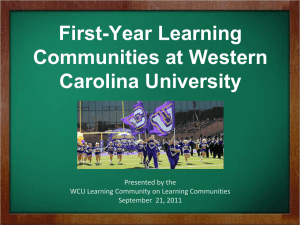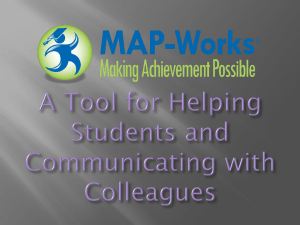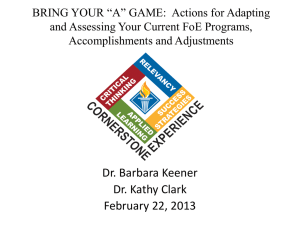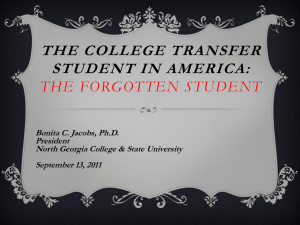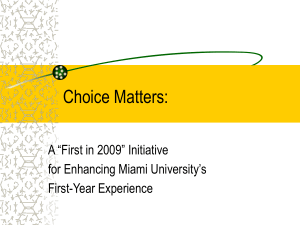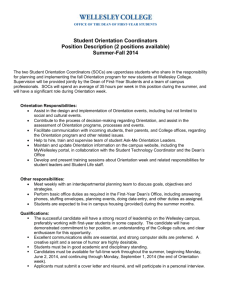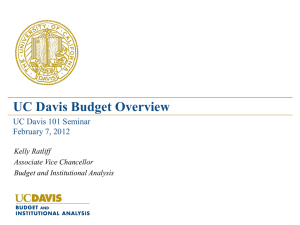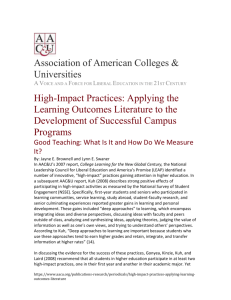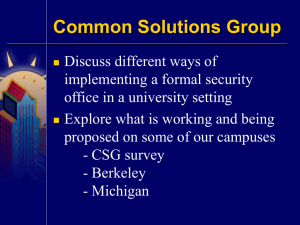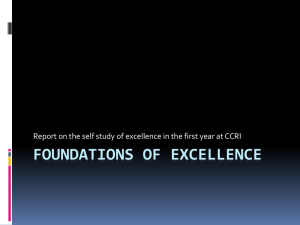Goals are Dreams With Deadlines - National Institute for the Study of
advertisement
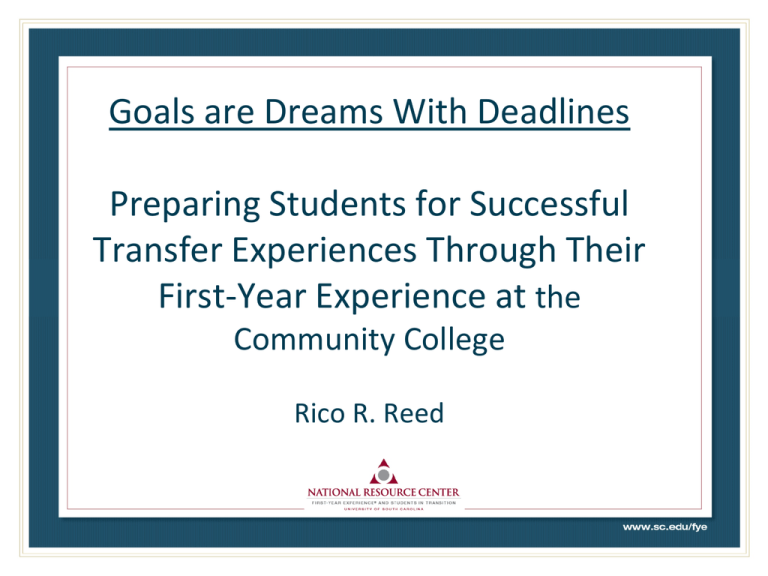
Goals are Dreams With Deadlines Preparing Students for Successful Transfer Experiences Through Their First-Year Experience at the Community College Rico R. Reed Outcomes of this Session • Explore how the First-Year Experience in the community college sets the foundation for a successful transfer process • Highlight the characteristics of community colleges that support a comprehensive and effective first-year experience • Provide rationale and highlight best practices for establishing an efficient and effective pipeline for best supporting students as they strive to execute their transfer dreams Fulfilling the Promise of the Community College: Increasing First-Year Student Engagement and Success Transfer Students in Higher Education: Building Foundations for Policies, Programs and Services That Foster Student Success Institute on First-Year Success in the Community College November 2011 Life’s Greatest Lessons: 20 Things that Matter Why are you here? What are your biggest challenges? What do your students need? Why hasn’t this been done in the past? What resources do you have? Who are your champions? Who are your supporters? What’s the ultimate payoff? • Motivation and goals are the greatest source of human power and the seeds to success. • All achievements are ignited as goals and fueled through motivation. • The goals we set and the depth of our motivation determines what we make of our lives. Limitless Describes the distinctive characteristics of firstyear student experiences and challenges in community college based on research and effective practice. Community colleges have gone from being the stepchild to being the golden child… Dr. Frank Chong, Deputy Assistant Secretary for Community Colleges Key to nation’s effort’s to double the number of college graduates in the next ten years The first-year, indeed the first few weeks of the beginning semester, is a pivotal point in students’ academic careers. Brown, King, & Stanley, 2011 Why Are Goals So Important? • Success is the progressive accomplishment of worthy goals. • Success starts with a mission: a specific goal accompanied by a strong desire. • Living without goals is like going on a trip without a destination! • “What the mind of man can conceive and believe, it can achieve.” Napoleon Hill We Know That … community colleges will play a central role in improving educational access for increasing numbers of U.S. college students • In order for increased access to be meaningful, students must persist in college, complete their programs, and where applicable, transfer to four-year institutions. • Effective first-year programs turn access into success by keeping students in college and helping them overcome barriers that might otherwise prevent them from reaching their goals. Two important themes …. (a) The first-year, as the springboard for student success, matters just as much in two-year institutions as it does in their fouryear counterparts, and (b) even when considering specific institutional contexts and cultures, standards of best practice for institutional support and success of first-year students in community colleges are emerging. Students whose first experiences are positive … are more likely to persist toward their goals, whether that is a certificate, an associate degree, or transferring to a four-year institution. Overarching principles... The learning college movement: how do you know what students are learning and achieving Overarching principles... The multiple missions of community colleges make them unique in the nation and world 20 Overarching principles... Measures of students success differ between two and four-year colleges due to diversity of students The Evolution of Colleges of Opportunity Community Colleges have evolved to include workforce and community development, lifelong learning and developmental education. Distinctive Characteristics of Community Colleges •Access, to Persistence, and Inclusion •Community Responsiveness and Innovation •Small class-size and a focus on teaching The Learning College Model and the Success and Completion Agenda now includes: Achieving the Dream Gates Foundation Postsecondary Success Initiative The Obama Administration Higher Education Agenda Voluntary Framework of Accountability Learning from Student Voices Dr. Kay McClenney, Director of the Center for Community College Student Engagement, created a portrait of the new community college student Asked why they persisted, students typically referred to a strong early connection to someone at the college… Benefits of Setting Goals • Motivation - Goals are the starting blocks of motivation. • Independence - Goals help us take charge of our own lives. • Direction - Goals give us a destination. We’re far more likely to get someplace when we know where we’re going. • Meaning - Goals give us a sense of purpose. Life has more meaning when we’re clear on what we want.. • Enjoyment - Goals are the antidote to the most dreaded of all social diseases: boredom. • Fulfillment - Goals, more than anything else, help us reach our potential. Setting goals helps us see what’s possible Benchmarks of Effective Practice with Entering Students some are Early connections Clear academic plan and pathway Academic & social support network What needs to be done Some are: Build a Culture of Evidence Commit to the discipline of routine student cohort tracking Bring programs to scale Goals = Greatness • Each goal completed helps us see more of what’s possible and leads to more goals and more success! Emerging evidence suggests that certain educational experiences may contribute significantly to the likelihood of students success. Examples include: College orientation programs First-year seminars Student success courses Leaning communities When A Dream Becomes A Goal • Goals are dreams with deadlines. • Goals become a blueprint for a very rewarding life. • Dreams don’t become a reality when they don’t have enough clarity. • The human mind won’t move in the direction of a generality; it will move when it has something specific to aim at. At some point it behooves community college educators to overcome their reluctance to make mandatory experiences shown to enhance student learning, persistence, and attainment. McClenney, 2011 Setting A Goal 1) Understand the difference between a goal and a wish. 2) Write down your goals and make them specific. 3) Categorize and balance your goals. 4) Review and revise your goals regularly. Recommendations Create intentionally-designed comprehensive programs Bring programs to scale Cultivate support from campus leadership Build coalitions on campus Develop community partnerships Provide campus-wide professional development opportunities Support transfer Establish relevant benchmarks for success Build a culture of evidence Create intentionally designed comprehensive programs Prioritize student programs and services focused on the initial adjustment to college Include academic and learning support programs Seek innovative and effective interventions Create intentionally designed comprehensive programs Academic advising and career development are the pillars of a comprehensive program Empower staff to accomplish the program mission Group services together Bring programs to scale Include a transition plan for movement from: Boutique service to universal student access Grant funding to base budget Link programs to accreditation processes Remember, students don’t do optional! Goal: 75% participation rates for FY students Cultivate support from campus leadership Include campus leadership in program: Development Implementation Maintenance Communication is key Select the right people to coordinate the program Cultivate support from campus leadership Connect the program to the mission, vision, values, and culture of the campus Have data to Support program decisions Document effectiveness Draw support from leadership across the campus Build coalitions on campus Cross-campus collaboration is likely to draw the attention and support of campus leadership Draw upon the “horizontal” nature of FYE to build partnerships New partnerships contribute to program evolution & improvement Develop community partnerships Enlist political, business, and community leaders Campus messaging should show campus as a destination of choice Include community leaders and members in the communication plan Develop community partnerships Career focused programs create a bridge to the community Placement services Members of advisory board and committees for career programs Use career programs as a model for other community partnerships Provide campus-wide professional development opportunities Professional development is an ongoing commitment Opportunities should fit the context: Community college specific Fit with the campus mission and student needs Consider professional development as a requirement Provide campus-wide professional development opportunities Programs should create a safe space for reflection and innovation Focus on cross-training across roles, programs, disciplines, etc. Integration into reward, recognition, & promotion expectations Support transfer Successful transfer begins when students enter the community college Examine the connections of current programs with four-year institutions Efforts and initiatives for transfer must be present in marketing efforts Support transfer Programs at the community college that are critical to successful preparation and transfer include: Academic advising Career development Academic support Initiatives that support STEM students Establish relevant benchmarks for success Connect success metrics to your institution’s mission, goals, and student needs Create multiple success measures Develop new metrics for success Still need to consider completion Establish relevant benchmarks for success Establish a realistic timeline to achieve the benchmarks If your benchmarks are normative, be sure to identify appropriate comparison groups Important to commit to accountability Build a culture of evidence Draw upon quantitative and qualitative data Link assessment data to metrics of success Critical to use consistent definitions Establish comprehensive information and tracking systems Build a culture of evidence Employ accountability measures that provide meaningful data Model data-driven decision making Engage in national data collection/research efforts Make data widely available to campus partners Summary • Goals give us direction and purpose. • Goals add meaning to our lives. • Goals challenge us. • Goals make life more interesting. • Goals make life more rewarding. • Goals make life better. SETTING GOALS What are three things you can do in the next MONTH to advance your plans for transfer student success? February 26 2012 SETTING GOALS What are three things you can do in the next 6 MONTHS to advance your plans for transfer student success? July 26 2012 SETTING GOALS What are three things you can do in the next YEAR to advance your plans for transfer student success? January 26 2013 QUESTIONS? ADDITIONAL THOUGHTS? Goals are Dreams With Deadlines Rico R. Reed Assistant Director for Administration and Resource Development National Resource Center for The First-Year Experience and Students in Transition rico@sc.edu 803.777.6225
